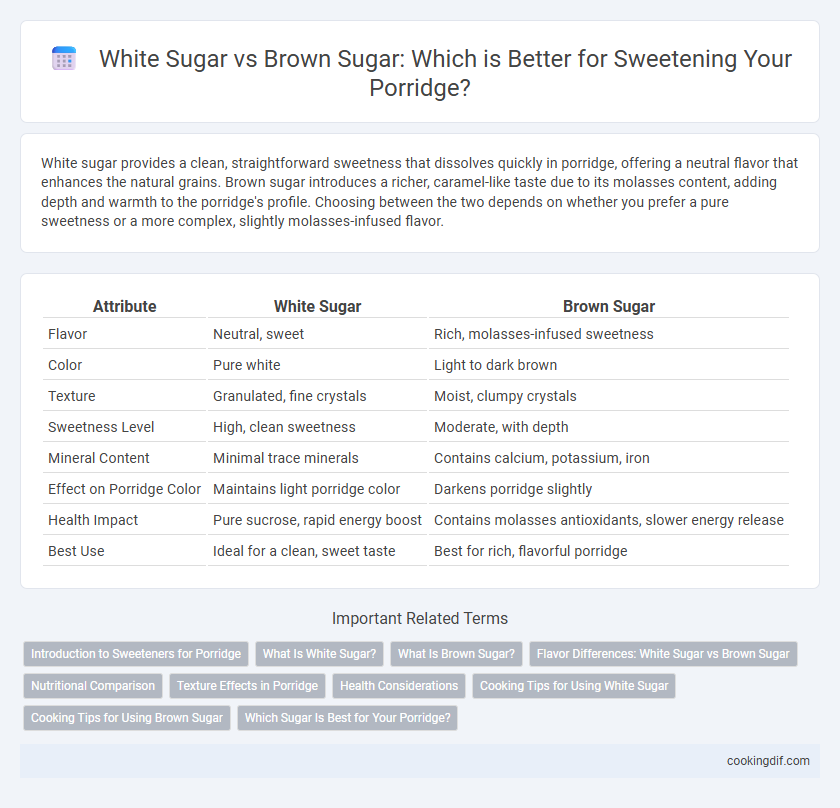White sugar provides a clean, straightforward sweetness that dissolves quickly in porridge, offering a neutral flavor that enhances the natural grains. Brown sugar introduces a richer, caramel-like taste due to its molasses content, adding depth and warmth to the porridge's profile. Choosing between the two depends on whether you prefer a pure sweetness or a more complex, slightly molasses-infused flavor.
Table of Comparison
| Attribute | White Sugar | Brown Sugar |
|---|---|---|
| Flavor | Neutral, sweet | Rich, molasses-infused sweetness |
| Color | Pure white | Light to dark brown |
| Texture | Granulated, fine crystals | Moist, clumpy crystals |
| Sweetness Level | High, clean sweetness | Moderate, with depth |
| Mineral Content | Minimal trace minerals | Contains calcium, potassium, iron |
| Effect on Porridge Color | Maintains light porridge color | Darkens porridge slightly |
| Health Impact | Pure sucrose, rapid energy boost | Contains molasses antioxidants, slower energy release |
| Best Use | Ideal for a clean, sweet taste | Best for rich, flavorful porridge |
Introduction to Sweeteners for Porridge
White sugar and brown sugar are common sweeteners used for porridge, each offering distinct flavors and nutritional profiles. White sugar provides a clean, intense sweetness with negligible minerals, ideal for a straightforward taste. Brown sugar contains molasses, adding a richer, caramel-like flavor and trace minerals like calcium, potassium, and iron, which can subtly enhance the nutritional value and complexity of porridge.
What Is White Sugar?
White sugar, also known as refined granulated sugar, is a highly processed sweetener derived from sugar cane or sugar beets. It undergoes purification to remove molasses and impurities, resulting in pure sucrose crystals with a neutral flavor. White sugar dissolves quickly, making it a popular choice for sweetening porridge due to its consistent sweetness and smooth texture.
What Is Brown Sugar?
Brown sugar is a type of sugar that contains molasses, giving it a moist texture and a rich, caramel-like flavor that enhances the taste of porridge. Unlike white sugar, which is more refined and lacks molasses, brown sugar provides additional minerals such as calcium, potassium, iron, and magnesium. Its deeper flavor profile makes it a popular choice for sweetening porridge, adding complexity and a natural sweetness that complements the grain's earthiness.
Flavor Differences: White Sugar vs Brown Sugar
White sugar offers a clean, straightforward sweetness that enhances porridge without altering its natural flavor profile, making it ideal for those who prefer a milder taste. Brown sugar imparts a richer, caramel-like flavor due to its molasses content, adding depth and warmth to the porridge. Choosing between white and brown sugar depends on desired flavor intensity, with brown sugar providing a more complex sweetness.
Nutritional Comparison
White sugar and brown sugar differ primarily in mineral content and processing, with brown sugar retaining molasses that provides small amounts of calcium, potassium, iron, and magnesium. Both sugars contain similar calories and carbohydrates, but brown sugar offers marginally more nutrients due to its molasses content, making it a slightly more nutritious option for sweetening porridge. However, the overall impact on porridge's nutritional profile remains minimal, as both sugars contribute primarily to sweetness rather than significant health benefits.
Texture Effects in Porridge
White sugar dissolves quickly in porridge, creating a smooth and consistent texture without altering the porridge's natural creaminess. Brown sugar, containing molasses, adds moisture and a slightly sticky texture, which can make the porridge feel richer and more velvety. The choice between white and brown sugar directly influences the mouthfeel, with brown sugar enhancing thickness and white sugar maintaining a lighter, more fluid consistency.
Health Considerations
White sugar provides quick energy but lacks essential nutrients, while brown sugar contains small amounts of minerals like calcium, potassium, and iron due to its molasses content. Despite these differences, both sugars have similar calorie content and can impact blood sugar levels, making moderation important for managing diabetes or weight. Choosing brown sugar may offer slight nutritional benefits, but overall health considerations emphasize limiting added sugars in porridge for better metabolic health.
Cooking Tips for Using White Sugar
White sugar dissolves quickly in porridge, offering a clean, sweet flavor that enhances the natural taste of grains without altering texture. For optimal results, add white sugar towards the end of cooking to prevent crystallization and maintain a smooth consistency. Using measured amounts ensures balanced sweetness, avoiding overpowering the porridge's subtle flavors.
Cooking Tips for Using Brown Sugar
Brown sugar enhances porridge with its rich molasses flavor and moist texture, making it an ideal sweetener for a comforting breakfast. When cooking porridge, add brown sugar towards the end of the simmering process to prevent crystallization and to maintain its deep caramel notes. For optimal sweetness and consistency, dissolve brown sugar in a small amount of hot water before stirring it into the porridge.
Which Sugar Is Best for Your Porridge?
White sugar offers a clean, straightforward sweetness that enhances porridge without altering its color or texture, making it ideal for those who prefer a classic taste. Brown sugar contains molasses, imparting a richer, caramel-like flavor and a slightly moist texture, which can add depth and warmth to your porridge. Choosing between white and brown sugar depends on your desired flavor profile and nutritional considerations, with brown sugar providing trace minerals and a more complex taste.
White sugar vs Brown sugar for sweetening porridge Infographic

 cookingdif.com
cookingdif.com